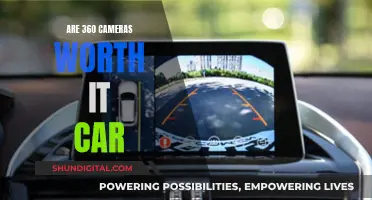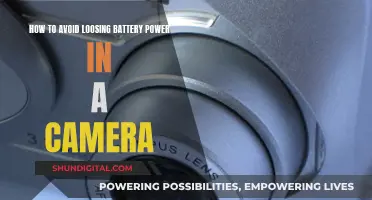
Whether or not a Polaroid camera requires batteries depends on the model and the type of film used. All automatic Polaroid cameras use batteries to power their shutters and built-in timers. The Model 850/900, J33/66 Electric Eyes, for example, are powered by mercury cells that are no longer available worldwide. On the other hand, manual cameras like the 180/195, Holgaroids, and simple pack film backs for other camera systems require no power to expose or develop images. The Polaroid OneStep 600 series, which uses Polaroid's 600 Platinum film, has a battery located inside the film cartridge. Therefore, if the camera won't turn on, the issue likely lies with a dead battery in the film cartridge. Newer Polaroid cameras have built-in rechargeable batteries and do not require a battery in the film cartridge.
What You'll Learn
- Polaroid 600 OneStep series: The camera uses a film cartridge with its own battery
- Polaroid i-Type film: This film type is exclusive to new Polaroid cameras with built-in rechargeable batteries
- Polaroid 600 film: The most common film type for vintage Polaroid cameras, with a blue package
- Polaroid SX-70 film: This film is for SX-70 cameras and is available in classic colour and black and white editions
- Polaroid Go film: The newest and smallest format for the Polaroid Go camera, with a double pack of colour film

Polaroid 600 OneStep series: The camera uses a film cartridge with its own battery
The Polaroid OneStep 600 Instant Camera is a popular choice for those seeking a vintage Polaroid camera experience. This camera boasts a contemporary design, capturing Polaroid's signature instant images with focus-free simplicity. Its built-in automatic flash and selectable close-up lens for shots between 2 and 4 feet enhance its functionality.
Regarding its power source, the Polaroid OneStep 600 relies on a unique system. Unlike modern cameras with dedicated battery compartments, this camera draws its power from the film cartridge itself. Each film cartridge contains a tiny battery designed to provide just enough power for approximately ten shots. This design feature is specific to vintage Polaroid cameras using 600 film, such as the OneStep 600 model.
When using the Polaroid OneStep 600, it is important to ensure that the film cartridge is not expired. Expired film cartridges may have depleted batteries, preventing the camera from functioning properly. In such cases, the issue is not with the camera but with the film cartridge's battery.
To address this, you can transfer the film from a cartridge with a dead battery to one with a working battery. This process must be performed in complete darkness, as even a safety light can affect the film. Practising the transfer process with previously exposed Polaroids will help you perfect the technique.
By following these steps, you can ensure that your Polaroid OneStep 600 Instant Camera continues to capture memorable moments, fuelled by the power provided by each film cartridge's dedicated battery.
Coolpix Cameras: CMOS Battery Power Source?
You may want to see also

Polaroid i-Type film: This film type is exclusive to new Polaroid cameras with built-in rechargeable batteries
Polaroid cameras have been around for decades, with the vintage models using film cartridges that contain a small battery to power the camera for about ten shots. However, modern Polaroid cameras have built-in rechargeable batteries, eliminating the need for battery-powered film cartridges. This new type of film is called Polaroid i-Type film, and it's exclusive to Polaroid's newest cameras with built-in batteries, such as the Polaroid Now, Now+, and Lab, as well as the I-2 instant camera.
The Polaroid i-Type film is a modern film made for modern instant cameras. It offers 8 instant photographs in the original Polaroid square format, finished in a white frame. The film is battery-free, which means it won't work with vintage Polaroid cameras. However, it's an excellent option for those using the newer Polaroid cameras with built-in rechargeable batteries. The rechargeable batteries in these newer cameras eliminate the need for battery-powered film, making the i-Type film a more cost-effective option.
The i-Type film provides 8 instant photos, allowing you to capture dramatic shadows and soft highlights. It's made with 100% Polaroid chemistry and created in the last Polaroid film factory in the world, located in Enschede, Netherlands. The film is compatible with specific Polaroid camera models, including the I-2, Now, Now+, and Lab. It's important to note that the i-Type film won't work with vintage Polaroid cameras due to its lack of a built-in battery.
You can purchase the Polaroid i-Type film in various pack sizes and colours, including black and white and colour frames. The development time for the i-Type film is around 5 to 15 minutes, allowing you to watch one of the most complex chemical processes bring your photographs to life. The film embodies the iconic Polaroid aesthetic and is a great choice for those looking to capture beautifully imperfect moments in the dreamlike Polaroid colour and finish.
Kodak Camera Charging: How to Know It's Charging?
You may want to see also

Polaroid 600 film: The most common film type for vintage Polaroid cameras, with a blue package
Polaroid 600 film is the most common film type for vintage Polaroid cameras, identifiable by its blue package. The film is compatible with a range of Polaroid cameras, including the 600, Impulse, SLR680, and newer i-Type One Step 2 models.
The film is available in both colour and black-and-white options, with the latter known as the B&W 600 Film. The colour film produces photos with white or round frames, while the black-and-white film offers monochrome frames.
Polaroid 600 film is sold in various quantities, including single, double, triple, and five packs, with the number of photos corresponding to the number of packs. For example, a single pack contains eight photos, while a five pack contains 40 photos.
The film is easy to install and produces high-quality, unique images with a rich texture. Each photo is one-of-a-kind, with no two pictures turning out the same. It is important to note that Polaroid 600 film requires ample light to produce the best results. The more light in the shot, the better the photo will turn out. Therefore, it is recommended to always use the camera flash, even for outdoor shots, unless it is a bright sunny day.
Additionally, all photos appear blank at first and take about 15 minutes to develop. During this time, it is crucial to shield the photos from light and place them face down as they develop.
Charging Camera Batteries: DIY Home Hacks
You may want to see also

Polaroid SX-70 film: This film is for SX-70 cameras and is available in classic colour and black and white editions
Polaroid cameras are known for their unique design and functionality, with some models relying on batteries embedded in the film cartridge itself rather than a separate power source. This design decision has its advantages and challenges, as we will explore in this discussion about Polaroid SX-70 film.
The Polaroid SX-70 film is specifically designed for SX-70 cameras and offers a unique analogue photography experience. This film is available in two distinct editions: classic colour and black and white. Each pack of SX-70 film contains eight instant photographs in the original Polaroid square format, framed by a white border. The film's speed (ASA) is intentionally lower, resulting in images with a richer texture and finer grain. To achieve optimal results, photographers are advised to shoot with ample natural light.
The history of Polaroid SX-70 film is quite fascinating. Introduced in 1972, it was hailed as 'magic' by photographers and enthusiasts alike. The film allowed users to capture and develop images instantly with just the push of a shutter button, eliminating the need for any human contact during the development process. This innovative feature captivated artists, professionals, and dreamers, who continue to cherish the film for its rich aesthetics even to this day.
However, one challenge associated with vintage Polaroid cameras, including the SX-70, is the reliance on film cartridges with built-in batteries. These batteries are designed to power the camera for approximately ten shots. As a result, users may encounter situations where the camera fails to operate due to a dead battery in the film cartridge. This issue is particularly common with expired genuine Polaroid film that has been sitting on shelves for extended periods. In such cases, the film can be rescued by transferring it to a new cartridge with a functioning battery, although this process must be performed in complete darkness to avoid exposing the film prematurely.
Despite the occasional hurdle, the Polaroid SX-70 film continues to be sought after by photographers worldwide. Its unique characteristics and the iconic Polaroid aesthetic it produces have cultivated a dedicated following. With limited stocks available from the sole remaining Polaroid film factory in the Netherlands, the demand for this film remains high, and the company is committed to meeting it.
Charging the FinePix XP120: A Step-by-Step Guide
You may want to see also

Polaroid Go film: The newest and smallest format for the Polaroid Go camera, with a double pack of colour film
The Polaroid Go film is the newest and smallest format for the Polaroid Go camera. Each double pack includes 16 colour instant photos framed in glossy white, with the same Polaroid quality, only smaller. The film is compatible only with the Polaroid Go camera. It is created in the last Polaroid film factory in the world and is 100% Polaroid chemistry.
The Polaroid Go film is a great addition to your camera, allowing you to capture all of life's moments as they happen. The film is truly pocket-sized and comes in classic white or matte-black frames. It is important to note that temperature affects how the film works. It is recommended to store the film chilled in the fridge, but never freeze it. Before use, allow the film to adjust to room temperature.
When shooting with the Polaroid Go film, remember that light is essential. The more light in your shot, the better your photo will turn out. Instant film loves light, especially natural light. Be sure to use the flash for all your indoor photos. After taking a photo, the image will appear blank at first and will be most sensitive during this time. Do not bend or shake the film. Shield it from the light and place it face down for about 6 minutes as it develops.
The Polaroid Go film is a fun and creative way to capture memories and add a nostalgic touch to your photography. The compact size of the film and the camera makes it easy to carry around wherever you go.
BestBuy's Camera Restocking Fee: Why the Extra Charge?
You may want to see also
Frequently asked questions
All Polaroid camera models require power to take a photo. Whether that power is mechanical, electrical, or a combination of both depends on the film type.
Vintage Polaroid cameras do not have batteries. The film cartridge itself has a tiny battery that has just enough power to allow for ten shots.
Modern Polaroid cameras have a built-in rechargeable battery, so they don't need a battery to power the camera.







